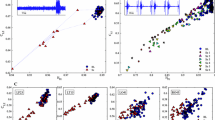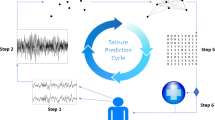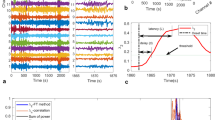Abstract
Epilepsy is a brain disorder characterized clinically by temporary but recurrent disturbances of brain function that may or may not be associated with destruction or loss of consciousness and abnormal behavior. Human brain is composed of more than 10 to the power 10 neurons, each of which receives electrical impulses known as action potentials from others neurons via synapses and sends electrical impulses via a sing output line to a similar (the axon) number of neurons. When neuronal networks are active, they produced a change in voltage potential, which can be captured by an electroencephalogram (EEG). The EEG recordings represent the time series that match up to neurological activity as a function of time. By analyzing the EEG recordings, we sought to evaluate the degree of underlining dynamical complexity prior to progression of seizure onset. Through the utilization of the dynamical measurements, it is possible to classify the state of the brain according to the underlying dynamical properties of EEG recordings. The results from two patients with temporal lobe epilepsy (TLE), the degree of complexity start converging to lower value prior to the epileptic seizures was observed from epileptic regions as well as non-epileptic regions. The dynamical measurements appear to reflect the changes of EEG’s dynamical structure. We suggest that the nonlinear dynamical analysis can provide a useful information for detecting relative changes in brain dynamics, which cannot be detected by conventional linear analysis.
Similar content being viewed by others
References
Babloyantz A (1988) Chaotic dynamics in brain activity. In: Basar E (ed) Dynamics of sensory and cognitive processing by the brain. Springer, Berlin, pp 196–202
Babloyantz A, Destexhe A (1986) Low dimension chaos in an instance of epilepsy. Proc Natl Acad Sci USA 83:3513–3517
Babloyantz A, Destexhe A (1987) The Creutizfeld–Jacob disease in the hierarchy of chaotic attractor. In: Markus M, Muller S (eds) From chemical to biological organization. Springer, Berlin, pp 307–316
Babloyantz A, Salazar JM, Nicolis C (1985) Evidence of chaotic dynamics of brain activity during the sleep cycle. Phys Lett A III:152–156
Broomhead DS, King GP (1986) Physica D 20:217
Cao L (1997) Practical method for determining the minimum embedding dimension of a scalar time series. Physica D 110:43–50
Casdagli MC, Iasemidis LD, Sackellares JC, Roper SN, Gilmore RL, Savit RS, (1996) Characterizing nonlinearity in invasive EEG recordings from temporal lobe epilepsy. Physica D 99(2–3):381–399.
Casdagli MC, Iasemidis LD, Savit RS, Gilmore RL, Roper SN, Sackellares JC (1997) Non-linearity in invasive EEG recordings from patients with temporal lobe epilepsy. Electroenceph Clin Neurophysiol 102:98–105
Fell J, Roschke J, Beckmann P (1993) The calculation of the first positive Lyapunov exponent in sleep EEG data. Electroenceph Clin Neurophysiol 86:348–357
Fraser AM, Swinney HL (1986) Independent coordinates for strange attractors from mutual information. Phys Rev A 33:1134–1140
Grassberger P, Procaccia I (1983) Measuring the strangeness of strange attractors. Physica D 9:189–208
Iasemidis LD, Sackellares JC (1991) The evolution with time of the spatial distribution of largest Lyapunov exponent on the human epileptic cortex. In: Duke D, Pritchard W (eds) Measuring chaos in the human brain. World Scientific, Singapore, pp 49–82
Iasemidis LD, Sackellares JC (1996) Chaos theory and epilepsy. Neuroscientist 2:118–126
Iasemidis LD, Sackellares JC, Zaveri H, Williams WJ (1990) Phase space topography and Lyapunov exponent of electrocardiograms in partial seizures. Brain Topogr 2:297–201
Iasemidis LD, Sackellares JC, Savit RS (1993) Quantification of hidden time dependencies in the EEG within the framework of non-linear dynamics. In: Jansen BH, Brandt ME (eds) Nonlinear dynamical analysis of the EEG. 1990. World Scientific, Singapore, pp 30–47
Iasemidis LD, Principe JC, Czaolewski JM, Gilmore RL, Roper SN, Sackellares JC (1996) Spatiotemporal transition to epileptic seizures: a non-linear dynamical analysis of scalp and intracranial EEG recordings. In: Lopes da Silva F, Principe JC, Almeida LB (eds) Spatiotemporal models in biological and artificial systems. IOS, Amsterdam, pp 81–88
Kennel MB, Brown R, Abarbanel HDI (1992) Determining embedding dimension for phase-space reconstruction using a geometrical construction. Phys Rev A 45:3403–3411
Martinerie JM, Albano AM, Mees AI, Rapp PE (1992) Phys Rev A 45:7058–7064
Palus M (1996) Nonlinearity in normal human EEG: cycles, temporal asymmetry, nonstationarity and randomness, not chaos. Biol Cybern 75(5):389–396
Roschke J, Aldenhoff J (1991) The dimensionality of human’s electroencephalogram during sleep. Biol Cybern 64:307–313
Sauer T, Yorke JA, Casdagli MC (1991) Embedology. J Stat Phys 65:579–616
Shatz CJ (1981) Brain Sci 214(4521):652–653
Takens F (1981) Detecting strange attractors in fluid turbulence. In: Rand D, Young L-S (eds) Dynamical systems and turbulence. Springer, Berlin, pp 366–381
Thelier J, Rapp P (1996) Re-examination of the evidence for low-dimensional, non-linear structure in the human electroencephalogram. Electroenceph Clin Neurophysiol 98(3):213–22
Whitney H (1936) Differentiable manifolds. Ann Math 37:645
Author information
Authors and Affiliations
Corresponding author
Rights and permissions
About this article
Cite this article
Liu, CC., Pardalos, P.M., Chaovalitwongse, W.A. et al. Quantitative complexity analysis in multi-channel intracranial EEG recordings form epilepsy brains. J Comb Optim 15, 276–286 (2008). https://doi.org/10.1007/s10878-007-9118-9
Published:
Issue Date:
DOI: https://doi.org/10.1007/s10878-007-9118-9




